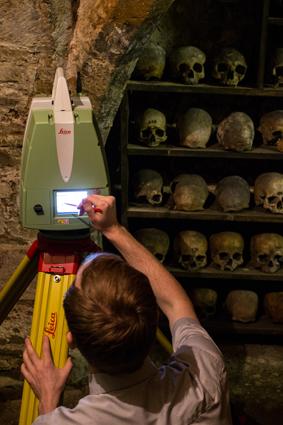 The University of Sheffield’s Department of Archaeology has joined forces with the school’s Advanced Manufacturing Research Centre (AMRC) and Boeing in a very unusual joint effort. They’re using 3D scanning technology to create a detailed, virtual model of a medieval ossuary, one of only two remaining in the United Kingdom. The project is somewhat outside of the typical purview of the AMRC, which most often creates virtual reality models for factory layout simulations. The VR models are used by companies in order to optimize manufacturing processes, but in this case, the objective is to preserve an important historical site and its contents.
The University of Sheffield’s Department of Archaeology has joined forces with the school’s Advanced Manufacturing Research Centre (AMRC) and Boeing in a very unusual joint effort. They’re using 3D scanning technology to create a detailed, virtual model of a medieval ossuary, one of only two remaining in the United Kingdom. The project is somewhat outside of the typical purview of the AMRC, which most often creates virtual reality models for factory layout simulations. The VR models are used by companies in order to optimize manufacturing processes, but in this case, the objective is to preserve an important historical site and its contents.
Heading the scanning project are metrology (the science of measurement) engineers Tom Hodgson and Adam Wiles, who have been using digital measuring techniques with the assistance of the AMRC to scan one of the two remaining medieval ossuaries in England, the Rothwell Charnel Chapel.  An ossuary is a chamber or vault that contains human skeletal remains. The chapel, also referred to as a charnel house or crypt, is located in the Church of the Holy Trinity in Rothwell, an historic market village in the Kettering district of Northamptonshire, England. It lies beneath the floor of the church, which is typical of medieval churches.
An ossuary is a chamber or vault that contains human skeletal remains. The chapel, also referred to as a charnel house or crypt, is located in the Church of the Holy Trinity in Rothwell, an historic market village in the Kettering district of Northamptonshire, England. It lies beneath the floor of the church, which is typical of medieval churches.
Scanning the chapel and its contents is an important effort in preserving a record of the data for future reference. A doctoral researcher from the Sheffield University Department of Archaeology and member of the project team, Jennifer Crangle, explained:
“As the stacks of bones will continue to degrade, the mass of the bones in future years can be compared to the scanning record, allowing us to document any changes over time. Rendering the data into a virtual reality model creates a permanent record of a unique site, allowing researchers and visitors to see the entirety of the exact crypt structure, as it has never been seen before.”
The team is creating a precise and permanent record of the 13th century crypt, which contains the skeletal remains of approximately 1,500 individuals, some of whom were first buried in the churchyard and then relocated at a later date. In 1580 or thereabouts, a new hospital was built on the grounds and more remains were moved to the crypt.  According to the church’s website, the crypt was reorganized at some point. The skulls were placed on shelves for display and the thigh bones or femurs arranged in two large, square piles in the center of the space. Why skulls and femurs? According to medieval superstition, those were the parts of the skeleton that were necessary for a body to be reconstituted at the Resurrection.
According to the church’s website, the crypt was reorganized at some point. The skulls were placed on shelves for display and the thigh bones or femurs arranged in two large, square piles in the center of the space. Why skulls and femurs? According to medieval superstition, those were the parts of the skeleton that were necessary for a body to be reconstituted at the Resurrection.
It was originally thought that ossuaries or crypts were created so that the bones of the departed could be reused in one way or another but now it is believed they were actually considered pilgrimage sites during the middle ages. They were quite common in Christian European countries, but the majority of those in England were destroyed after the Protestant Reformation.

Tom Hodgson operating the Leica ScanStation P20 laser radar inside the Rothwell Holy Trinity Church Ossuary. (Photo: AMRC)
Now there are only two such sites in the entirety of the UK and the bones are gradually degrading, so the project couldn’t be more timely or critical. The team used a Leica ScanStation P20 laser radar scanner to capture the crypt’s interior. The device remains in one place, spinning slowly a full 360 degrees so that as much detail as possible can be recorded.
“The method is a very quick way of gathering a lot of data, which will be built up into a 3D image or virtual reality model of the inside of the ossuary,” Hodgson remarked on this cutting-edge technique.
Since crypts are almost always below floor level in a church, sometimes mobility within them can be rather limited. Moving the scanning equipment from place to place in such an enclosed space was not possible, but the Leica ScanStation P20 enabled the research team to gather a great deal of information without moving around the limited space and without compromising the quality of the data, which was used to create the final virtual reality models.
As has been the case with other such efforts, including portions of the Lascaux Cave in southern France and the Tomb of King Tut, the 3D scans also make it possible to produce 3D printed replicas of artifacts and sites. In doing so, the original objects and sites are protected from damage by the elements and by visitors and the replicas can still provide invaluable insights for those who visit, view, and study them. Perhaps that will eventually be the case with the Rothwell crypt and its contents. Let us know which of these preservation projects stands out to you in the 3D Scanned Medieval Bone Crypt forum thread over at 3DPB.com.
Subscribe to Our Email Newsletter
Stay up-to-date on all the latest news from the 3D printing industry and receive information and offers from third party vendors.
Print Services
Upload your 3D Models and get them printed quickly and efficiently.
You May Also Like
Hyperion Robotics, UK National Grid to Use 3D Printing for Low-Carbon Substation Foundations
Hyperion Robotics, a Finnish provider of additive construction (AC) solutions specializing in low-carbon infrastructure projects, has partnered with UK utilities giant National Grid to test the use of 3D printed...
Ukrainian Researchers Partner with NSF, US Navy to Turn Debris Into New 3D Printed Buildings
Ukrainian researchers have started a project to try to turn waste from demolished buildings into new 3D printed ones. This is especially relevant in Ukraine, where tens of thousands of...
Verustruct’s Housing-Ready 3D Printing Tech and the Former SpaceX Engineer Behind It
Nick Callegari never planned on building houses. But after designing spacecraft parts at SpaceX, he decided to aim for something a little closer to home. The result is Verustruct, a...
RIC Robotics Teases Zyrex Giantroid Robot For Dreambuilding
RIC Robotics is teasing the Zyrex, what it calls a Giantroid. 6 meters in height with a 7 meter span, the autonomous (but human-monitored) construction robot is slated for release...

































